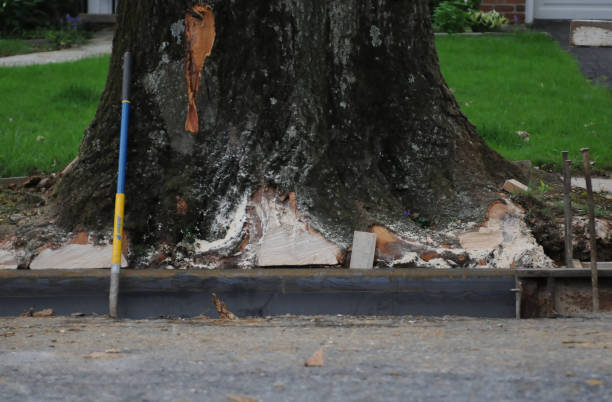The reason tree roots penetrate sewer lines is simple.
Looking for oxygen and water roots penetrate the tiniest cracks in your sewer line pipe. Sewer line pipes carry lots of water, making them the best sources of water and nutrients.
This is good news for the tree, but bad news for the pipe.
If there is any crack, no matter how tiny, the consistent supply of water and nutrients will cause the roots to expand to fill the pipe, and consequently, cause more damage.
Before the issue becomes critical, you may start to notice the slow draining of water or some gurgling sound when you flush. These are the earliest signs of tree roots clogging your sewage pipe.
[lwptoc]
How Do Roots Get into the Sewer Line?

As mentioned earlier, roots seek out water and oxygen. When a sewer line pipe has a crack, water comes out of it. This leak draws nearby roots looking for water. Roots then start to penetrate the crack for more water and nutrients.
A loose joint is also a vantage point for roots to sense moisture and penetrate your sewer line pipe.
These roots could be from one of the trees in your yard or anywhere around your house. A tree within 20 meters of your sewer line pipe is a prime suspect.
If your house is old, there is a chance your sewer line pipes are weak. The sewer line pipes in many old homes are concrete or clay pipes.
These pipes become weak after a decade or two.
Houses built in the 1980s and older are in this category. As such, the U.S. building codes no longer approve some of the pipes available then.
Warning Signs of Roots in Sewer Line Pipes
When water starts to drain slowly, there is a chance there are tree roots in your sewer line pipe. It could even be the case that when you flush, you hear some gurgling sounds.
At this stage, you’re getting early warning signs.
It becomes a matter of urgent attention when water backs up when you flush. Calling a plumber at this stage is crucial.
However, the best time to call a plumber is when you start to notice the slow draining of water. The slow draining means that something is clogging your pipe.
When you hear gurgling sounds from your toilet, it is because, as water slowly moves through the drain, air bubbles begin to form, and they produce that sound.
If you ignore these signs, they’re going to become worse. When tree roots enter your sewer line pipe, they expand to fill the pipe. After too much pressure from the growing tree roots, the pipe breaks, resulting in expensive repairs that you can’t avoid.
When breakage occurs in your sewer line pipes, you may start to notice a sinkhole around your house. Sinkholes result from water eroding the soil. A sinkhole is harmful to the foundation of your home. It is a warning sign you should not ignore.
The sinkhole emits a foul odor that starts to circulate the area.
All these are warning signs that you need to repair your sewer line.
How Do Tree Roots Damage Sewer Line Pipes?
The water coming out of a sewer line pipe crack or loose joint is an invitation for roots. The pipe contains water, oxygen, and enough nutrients the root needs. Naturally, you’d expect it to move closer to the source to get enough of these.
When roots penetrate, they gradually expand to fill the pipe. The water, excreta, and toilet paper from your toilet become stuck when they get to the root growth. When these get to a point, there’s a total blockage of the pipe, and your toilet becomes useless.
Tree roots in your sewer line pipe can also lead to breakage. When tree roots get enough nutrients, they can grow to fill the pipe and exert too much pressure on it. This pressure can lead to the pipe breaking.
How to Get Roots Out of Your Sewer Line Pipes
When you start to see the signs of tree roots in your sewer line pipe, here are a few things you can do:
1. Call a Professional
Nothing beats getting a professional to handle something as technical as a blocked sewer line pipe. Apart from the fact that this saves you lots of stress, you also fully solve the problem.
A plumber can conduct a sewer camera inspection to know exactly where the roots are and fix the problem immediately.
The only thing you need to do is get a certified plumber with experience in dealing with sewer line pipes invaded by roots.
2. Use Rock Salt
Rock salt is a popular solution for removing tree roots in your sewer line pipe. Rock salt sucks moisture from roots. The loss of water kills them.
You can get rock salt at a local store, or you could just buy it from Amazon.
Get about 2 pounds of rock salt ready, and first empty half a pound into your toilet. Flush as many times as you need to for the salt to go. Do this until the 2 pounds of rock salt is gone.
Leave it for about 12 hours, and while you’re gone, don’t flush it or run water through it.
By the time you’re back, the clog should be gone. If not, call a plumber. The problem could be more than you think.
3. Try Foaming Root Killers
Foaming Root Killer works effectively against root growth in your sewer line pipe. It does not only remove the roots presently in your pipes but also helps against future occurrences.
Root killer foams when it contacts water. Pour the powder into your toilet and flush.
The root killing agent, dichlobenil, is released into the pipe, and it heads straight to the root growth.
You can do this once a month to prevent future occurrences of root growth in your sewer line.
4. Try Copper Sulfate
Copper Sulfate is also effective in killing roots in your sewer line pipes. You can get it at your local hardware store.
Just pour about half a cup down the toilet and flush as many times as needed to wash it off. Leave the house for a few hours and take your kids and pets with you.
Copper Sulfate is toxic and banned in some places. It can kill pets that come in contact with it.
You can check the local legislation in your area to find out if it is allowed for use.
Does Tree Root Killer Work?
Tree root killers work. They can effectively kill the roots in your sewer line pipe. However, they won’t repair the damage that has resulted from the invasion of your pipe.
The crack that was tiny before would most likely be big enough to cause noticeable leaks. With significant leaks in the pipe, water escapes from your toilet into the soil, eroding the soil around your house.
The erosion can lead to a sinkhole that can affect the foundation of your house.
How to Avoid Tree Roots Getting into the Sewer Line
Tree roots are sensitive to moisture, and they gravitate towards it. To keep tree roots away from your sewer line pipes, here are a few things you can do:
1. Replace Old Pipes
Old houses are elegant for their unique architecture and hardwood floor. However, their plumbing is old. The pipes used 40, 50, or 60 years ago can no longer be trusted. Heavy usage, elements, and microorganisms have taken their toll on those pipes over the decades.
It would help to replace those pipes. Plastic or steel would work very well as sewer line pipe materials. Plastic pipes are corrosion resistant, and they don’t have seams or vulnerable joints.
2. Check Your Drains Frequently
Regular inspections will save you a lot of stress and money. When you inspect your sewer-line pipes once every six months or a year, you’d be able to detect any unusual growth or clog in any of your pipes.
Professional plumbers have sewer inspection cameras. This equipment can extend long into your sewer line pipes to check if there is any obstruction.
3. Understand the Landscape of Your House
Of course, everyone should plant a tree in their lifetime. Our planet needs it. However, planting a tree in the wrong place can put you in serious trouble.
If you plant a tree within 20 meters of a vulnerable sewer line pipe, the pipe is in trouble. Tree roots can extend deep into the soil, looking for nutrients and water.
Call 811 Before You Dig to know where your utility lines are. Having this information at hand will let you know the safe place to plant your tree.
Does Homeowner Insurance Cover Tree Roots in My Sewer Line?
Unfortunately, homeowner insurance hardly covers the removal of tree roots in sewer lines. It could, however, cover the damage to your house if water escapes from a broken sewer pipe. This is because the escaping water caused damage to your home.
Generally, homeowner insurance does not cover home maintenance and repairs like water backing up in your toilet due to clogs in your sewer line.
What you can do is go over your insurance policy to see what is covered. Your insurance policy may cover repairs like that. Some insurers offer sewer or water backup coverage as a separate policy. You may want to consider this — as they are affordable.
How Much Does It Cost to Fix?
Having tree roots in a sewer line can cost you from $100 to a few thousand. It depends on the level of damage.
If all that is needed is to remove the roots, it may not cost you more than $100 to $200. For heavier repairs like changing your sewer line pipes, you may be looking at $700 to a few thousand dollars.
Effectively Getting Tree Roots Out of Your Sewer Line Pipe
Prevention will save you a lot more than money. You should conduct regular inspections on your sewer line pipes. Removing the roots and permanently putting an end to their stay in your sewer lines would cost you far less than when you have a critical issue like water backing up or a sinkhole.
Accurate Leak and Line is a certified pipe rehabilitation and underground plumbing repair expert. We’ve been serving customers in Texas since 2002, using dynamic solutions to create an environmentally safe and sound pipe infrastructure rehabilitation process for our customers.
Get in Touch with Accurate Leak and Line today to discuss your plumbing problems and get a quote.





